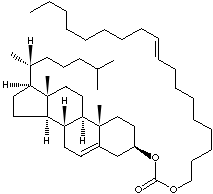PRODUCT IDENTIFICATION

H.S. CODE
TOXICITY
CLASSIFICATION
PHYSICAL AND CHEMICAL PROPERTIES
AUTOIGNITION
NFPA RATINGS
REFRACTIVE INDEX
Stable under ordinary conditions.
GENERAL DESCRIPTION & APPLICATIONS
APPEARANCE
ASSAY
99.0% min
OPTICAL ROTATION
-20° ~ -24° (c=2 in CHCl3)
- CHOLESTERYL ACETOACETATE
- CHOLESTERYL ACETATE (CAS RN: 604-35-3)
- CHOLESTERYL ARACHIDONATE (CAS RN: 604-34-2)
- CHOLESTERYL BEHENATE (CAS RN: 61510-09-6)
- CHOLESTERYL BENZOATE (CAS RN: 604-32-0)
- CHOLESTERYL BROMIDE (CAS RN: 516-91-6)
- CHOLESTERYL BUTOXYPHENYLCARBONATE
- CHOLESTERYL BUTYL ETHER (CAS RN: 10322-03-9)
- CHOLESTERYL TERT-BUTYL ETHER
- CHOLESTERYL BUTYRATE (CAS RN: 521-13-1)
- CHOLESTERYL CAPRATE (CAS RN: 1183-04-6)
- CHOLESTERYL CAPROATE (CAS RN: 1062-96-0)
- CHOLESTERYL CAPRYLATE (CAS RN: 1182-42-9)
- CHOLESTERYL CHLORIDE (CAS RN: 910-31-6)
- CHOLESTERYL-P-CHLOROBENZOATE
- CHOLESTERYL CHLOROFORMATE (CAS RN: 7144-08-3)
- CHOLESTERYL-P-CHLOROPHENYLACETATE
- CHOLESTERYL-3-CHLOROPROPIONATE
- CHOLESTERYL CINNAMATE (CAS RN: 1990-11-0)
- CHOLESTERYL COUMARIN-3-CARBOXYLATE (CAS RN: 196091-78-8)
- CHOLESTERYL CROTONATE
- CHOLESTERYL DECYLATE
- CHOLESTERYL CROTYLCARBONATE (CAS RN: 62637-94-9)
- CHOLESTERYL-2,4-DICHLOROBENZOATE (CAS RN: 32832-01-2)
- CHOLESTERYL-3,4-DICHLOROBENZOATE (CAS RN: 32834-71-2)
- CHOLESTERYL 3BETA-N-(DI METHYL AMINO ETHYL) CARBAMATE HYDROCHLORIDE (CAS RN: 166023-21-8)
- CHOLESTERYL-3,5-DINITROBENZOATE (CAS RN: 25279-63-4)
- CHOLESTERYL ELAIDATE (CAS RN: 19485-76-8)
- CHOLESTERYL ERUCATE (CAS RN: 24516-39-0)
- CHOLESTERYL ETHYL ETHER (CAS RN: 986-19-6)
- CHOLESTERYL ETHYL CARBONATE
- CHOLESTERYL-2-(ETHOXYETHOXY)ETHYL CARBONATE (CAS RN: 15484-00-1)
- CHOLESTERYL-2-ETHYLHEXANOATE (CAS RN: 41329-01-5)
- CHOLESTERYL-2-ETHYLHEXYLCARBONATE
- CHOLESTERYL FORMATE (CAS RN: 4351-55-7)
- CHOLESTERYL-BETA-D-GLUCOSIDE
- CHOLESTERYL HEMISUCCINATE (CAS RN: 1510-21-0)
- CHOLESTERYL HEMISUCCINATE TRIS SALT (CAS RN: 102601-49-0)
- CHOLESTERYL HEPTADECANOATE (CAS RN: 24365-37-5)
- CHOLESTERYL HEPTYLATE (CAS RN: 1182-07-6)
- CHOLESTERYL HYDROGEN PHTHALATE
- CHOLESTERYL IODIDE
- CHOLESTERYL ISOAMYL ETHER
- CHOLESTERYL ISOBUTYRATE (CAS RN: 1180-43--4)
- CHOLESTERYL ISOPROPYL ETHER (CAS RN: 1255-86--3)
- CHOLESTERYL ISOSTEARYL CARBONATE (CAS RN: 127512-93-0)
- CHOLESTERYL ISOTRIDECYLCARBONATE
- CHOLESTERYL ISOVALERATE
- CHOLESTERYL LAURATE (CAS RN: 1908-11-8)
- CHOLESTERYL LINOLEATE (CAS RN: 604-33-1)
- CHOLESTERYL LINOLENATE (CAS RN: 2545-22-4)
- CHOLESTERYL METHYL CARBONATE (CAS RN: 15507-52--5)
- O-CHOLESTERYL S-METHYL DITHIOCARBONATE
- CHOLESTERYL METHYL ETHER (CAS RN: 1174-92-1)
- CHOLESTERYL METHYL SUCCINATE
- CHOLESTERYL MYRISTATE (CAS RN: 1989-52-2)
- CHOLESTERYL NERVONATE (CAS RN: 60758-73-8)
- CHOLESTERYL NITRATE
- CHOLESTERYL-P-NITROBENZOATE (CAS RN: 23838-12-2)
- CHOLESTERYL-P-NONYLPHENYL CARBONATE (CAS RN: 60474-62-6)
- CHOLESTERYL OLEATE (CAS RN: 303-43-5)
- CHOLESTERYL OLEYL CARBONATE (CAS RN: 17110-51-9)
- 2-(CHOLESTERYLOXY)ETHANOL
- CHOLESTERYL PALMITATE (CAS RN: 601-34-3)
- CHOLESTERYL PALMITELAIDATE (CAS RN: 102679-72-1)
- CHOLESTERYL PALMITOLEATE (CAS RN: 16711-66-3)
- CHOLESTERYL PELARGONATE (CAS RN: 1182-66-7)
- CHOLESTERYL PHENYLACETATE(CAS RN: 33998-26-4)
- CHOLESTERYL-P-PHENYL BENZOATE
- CHOLESTERYL PHOSPHORYL CHOLINE (CAS RN: 65956-64-1)
- CHOLESTERYL POLYETHYLENE GLYCOLS
- CHOLESTERYL PROPIONATE (CAS RN: 633-31-8)
- CHOLESTERYL N-PROPYL CARBONATE
- CHOLESTERYL PROPYL ETHER
- CHOLESTERYL 1-PYRENECARBOXYLATE (CAS RN: 253186-38-8)
- CHOLESTERYL (PYREN-1-YL)HEXANOATE (CAS RN: 96886-70-3)
- CHOLESTERYL STEARATE (CAS RN: 35602-69-8)
- CHOLESTERYL-P-TOSYLATE
- CHOLESTERYL N-(TRIMETHYLAMMONIOETHYL)CARBAMATE CHLORIDE (CAS RN: 188022-80-2)
- CHOLESTERYL TRICHLOROACETATE
- CHOLESTERYL UNDECANOATE (CAS RN: 30948-01-7)
- CHOLESTERYL VALERATE (CAS RN: 7726-03-6)
- CHOLESTERYL-P-NONYLOXYBENZOATE
- DICHOLESTERYL CARBONATE (CAS RN: 29331-39-3)
- DICHOLESTERYL SEBACATE
- DICHOLESTERYL SULFITE
- 7-KETOCHOLESTERYL ACETATE
- 6-NITROCHOLESTERYL BENZOATE
- PHENESTERIN (CAS RN: 3546-10-9)
- SODIUM CHOLESTERYL SULFATE
- THIOCHOLESTEROL (CAS RN: 1249-81-6)